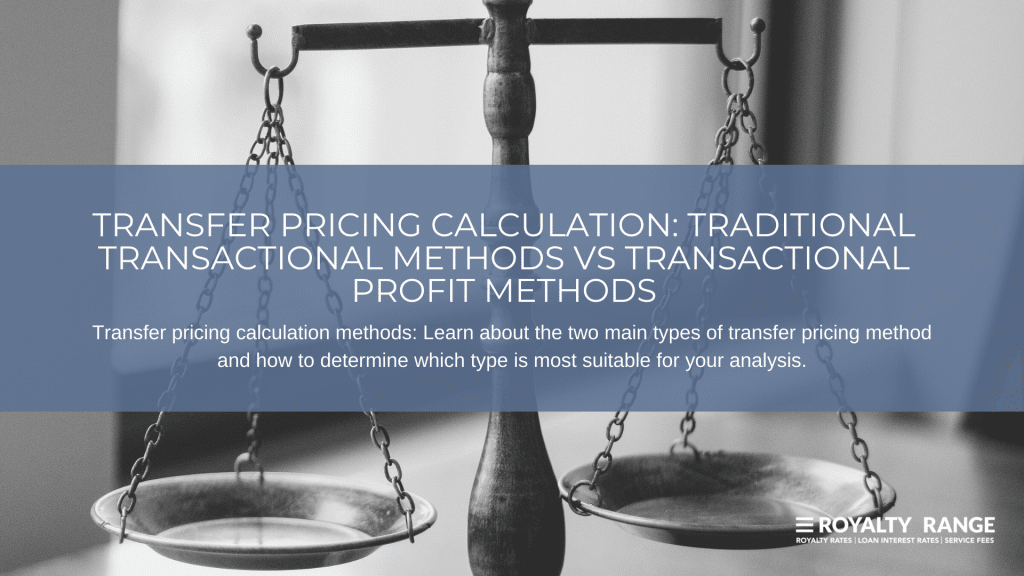Transfer Pricing Calculation: Traditional transactional methods vs transactional profit methods

Kris (Kestutis) Rudzika |
February 15, 2021

Traditional transactional methods and transactional profit methods are the two main types of method you can use when carrying out a transfer pricing calculation. But which type should you use for your analysis? What are the differences between them? Read on to find out.
What is a transfer pricing calculation?
If your company has multiple legal entities, you will need to set transfer prices for any intercompany transactions that occur – i.e. when products, services or intellectual property assets are transferred from one legal entity within your organization to another. For tax reasons, these transactions must occur ‘at arm’s length’ . This means that the conditions of the transaction must be the same as what they would have been had the transaction occurred between unrelated entities (companies that are legally independent of each other).
When you carry out a transfer pricing calculation, your aim is to determine whether the conditions of the intercompany transaction you are analyzing are consistent with the arm’s length principle – i.e. they are the same as they would have been had the transaction occurred between unrelated entities. You can use transfer pricing methods to help you set arm’s length transfer prices or to analyze a transaction for transfer pricing documentation.
Two main types of transfer pricing methods
There are multiple transfer pricing methods you can use to carry out a transfer pricing calculation. In the 2017 Transfer Pricing Guidelines, the OECD outlines five main methods.
These fall into two categories: traditional transaction and transactional profit methods.
The traditional transactional methods include:
- The comparable uncontrolled price (CUP) method: This method compares the conditions and remuneration of the transaction with those of a comparable uncontrolled transaction between unrelated, independent entities. It is a direct way to ensure arm’s length transfer pricing, as long as comparable data is available.
- The resale price method: This method uses the resale price at which a comparable asset is bought from an associated enterprise and sold to an unrelated entity. It finds the resale price margin that would be needed for the reseller to cover their costs and make a fair profit. The amount left after this margin is subtracted and adjustments are made is the arm’s length price for the controlled transaction being analyzed.
- The cost plus method: This method analyzes a controlled transaction between a supplier and purchaser (related entities). The arm’s length price is calculated by adding the supplier’s costs to a markup for the asset (ensuring that the supplier makes a fair profit and that the functions they performed are taken into account).
The transactional profit methods include:
- The transactional net margin method (TNMM)This method compares the net profit margin of the transaction being analyzed with the net profit margin of a comparable uncontrolled transaction between independent entities. It uses a net profit indicator, which is a ratio of the net profit against an appropriate base, such as sales or assets.
- The profit split method: This method analyzes how profits and losses are divided between independent enterprises in comparable uncontrolled transactions. The profits of the controlled transaction are split between the related entities in line with how they are split between independent enterprises in uncontrolled transactions.
The difference between traditional transaction methods and transactional profit methods
One of the main differences between the two types of method is the type of data they use for the analysis. Traditional transaction methods rely on comparable data from uncontrolled transactions between independent entities (i.e. external data on market transactions), while transactional profit methods use internal data from the controlled transaction in question.
Also, traditional transaction methods generally use gross profits (with the exception of the comparable uncontrolled price method that uses sales), while transactional profit methods use net profits.
Which type of method should I use?
It is important that you use the most appropriate method for the individual circumstances of your analysis. There is no one-size-fits-all approach to a transfer pricing calculation.
Saying that, the OECD does provide some guidance on selecting a transfer pricing method.
It suggests that traditional transaction methods are generally the “most direct” way of analyzing whether a controlled transaction is at arm’s length. If you have access to reliable comparables data for your transaction, a traditional transaction method is often suitable.
However, there are cases when transactional profit methods are more appropriate. These include transactions where each of the associated entities makes “unique and valuable contributions” or where the activities relevant to the transaction are “highly integrated”.
Here are some things to keep in mind when selecting a transfer pricing method:
- The strengths and weaknesses of each method
- The nature of the controlled transaction you’re analyzing
- The availability of reliable comparables data on uncontrolled transactions between independent entities
- The degree of comparability between the controlled and uncontrolled transactions
You can read more about selecting a transfer pricing method in Chapter 2 (Part 1) of the Transfer Pricing Guidelines.
Find reliable comparables data for your transfer pricing analysis
With the RoyaltyRange database, you can access real, recent data on comparable uncontrolled transactions between independent enterprises. Simply enter your search criteria (using the relevant search filters) and get a report of all the suitable licensing agreements in our database. Every licensing agreement in our database is between independent enterprises, and is checked against more than 50 comparability factors.
Get data for your transfer pricing calculation today. Use the box on the right to start your search.
Request One Search
We will perform the search and deliver the initial results within hours, at no cost.




